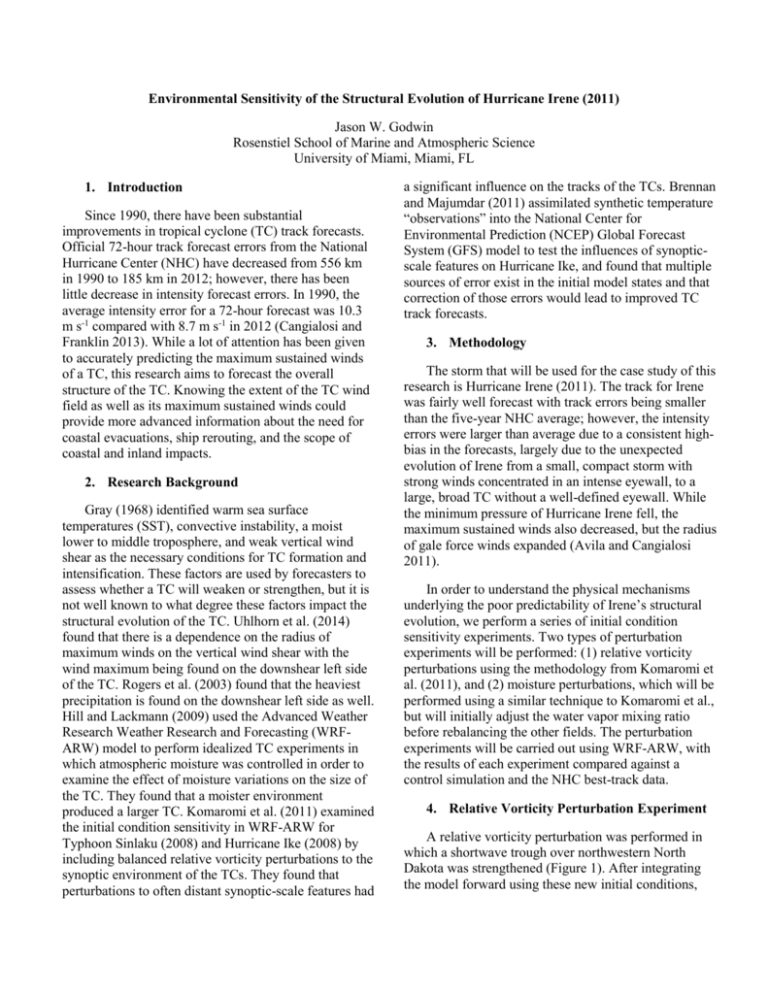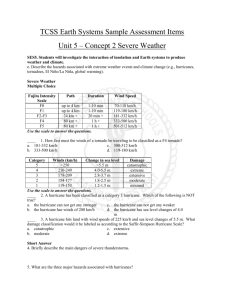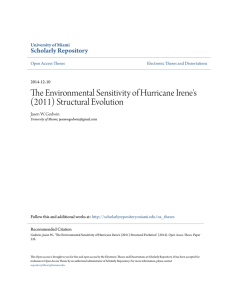Extended Abstract - Rosenstiel School of Marine and Atmospheric
advertisement

Environmental Sensitivity of the Structural Evolution of Hurricane Irene (2011) Jason W. Godwin Rosenstiel School of Marine and Atmospheric Science University of Miami, Miami, FL 1. Introduction Since 1990, there have been substantial improvements in tropical cyclone (TC) track forecasts. Official 72-hour track forecast errors from the National Hurricane Center (NHC) have decreased from 556 km in 1990 to 185 km in 2012; however, there has been little decrease in intensity forecast errors. In 1990, the average intensity error for a 72-hour forecast was 10.3 m s-1 compared with 8.7 m s-1 in 2012 (Cangialosi and Franklin 2013). While a lot of attention has been given to accurately predicting the maximum sustained winds of a TC, this research aims to forecast the overall structure of the TC. Knowing the extent of the TC wind field as well as its maximum sustained winds could provide more advanced information about the need for coastal evacuations, ship rerouting, and the scope of coastal and inland impacts. 2. Research Background Gray (1968) identified warm sea surface temperatures (SST), convective instability, a moist lower to middle troposphere, and weak vertical wind shear as the necessary conditions for TC formation and intensification. These factors are used by forecasters to assess whether a TC will weaken or strengthen, but it is not well known to what degree these factors impact the structural evolution of the TC. Uhlhorn et al. (2014) found that there is a dependence on the radius of maximum winds on the vertical wind shear with the wind maximum being found on the downshear left side of the TC. Rogers et al. (2003) found that the heaviest precipitation is found on the downshear left side as well. Hill and Lackmann (2009) used the Advanced Weather Research Weather Research and Forecasting (WRFARW) model to perform idealized TC experiments in which atmospheric moisture was controlled in order to examine the effect of moisture variations on the size of the TC. They found that a moister environment produced a larger TC. Komaromi et al. (2011) examined the initial condition sensitivity in WRF-ARW for Typhoon Sinlaku (2008) and Hurricane Ike (2008) by including balanced relative vorticity perturbations to the synoptic environment of the TCs. They found that perturbations to often distant synoptic-scale features had a significant influence on the tracks of the TCs. Brennan and Majumdar (2011) assimilated synthetic temperature “observations” into the National Center for Environmental Prediction (NCEP) Global Forecast System (GFS) model to test the influences of synopticscale features on Hurricane Ike, and found that multiple sources of error exist in the initial model states and that correction of those errors would lead to improved TC track forecasts. 3. Methodology The storm that will be used for the case study of this research is Hurricane Irene (2011). The track for Irene was fairly well forecast with track errors being smaller than the five-year NHC average; however, the intensity errors were larger than average due to a consistent highbias in the forecasts, largely due to the unexpected evolution of Irene from a small, compact storm with strong winds concentrated in an intense eyewall, to a large, broad TC without a well-defined eyewall. While the minimum pressure of Hurricane Irene fell, the maximum sustained winds also decreased, but the radius of gale force winds expanded (Avila and Cangialosi 2011). In order to understand the physical mechanisms underlying the poor predictability of Irene’s structural evolution, we perform a series of initial condition sensitivity experiments. Two types of perturbation experiments will be performed: (1) relative vorticity perturbations using the methodology from Komaromi et al. (2011), and (2) moisture perturbations, which will be performed using a similar technique to Komaromi et al., but will initially adjust the water vapor mixing ratio before rebalancing the other fields. The perturbation experiments will be carried out using WRF-ARW, with the results of each experiment compared against a control simulation and the NHC best-track data. 4. Relative Vorticity Perturbation Experiment A relative vorticity perturbation was performed in which a shortwave trough over northwestern North Dakota was strengthened (Figure 1). After integrating the model forward using these new initial conditions, little model sensitivity was found, with the track, intensity, and wind radii in the perturbed simulation being very similar to those in the control simulation. Future moisture perturbation experiments will include increasing the moisture within the TC core, and changing the moisture in the environment ahead of the TC path. These moisture experiments will also be performed on a finer convection-permitting grid scale (3 km) in order to examine the impact of moisture on the convective structure of the TC. 6. References Avila, Lixion A., and John Cangialosi, 2011: Hurricane Irene. Tropical Cyclone Report, 45 pp. Figure 1: relative vorticity perturbation over northwestern North Dakota We plan to perform vorticity perturbation experiments in the future in which synoptic features are perturbed during the simulation (i.e. perturbations will be introduced to WRF restart files). Furthermore, we plan to perturb the TC vortex itself in order to examine the effects of TC outflow on the structural evolution. 5. Moisture Perturbation Experiment A moisture perturbation was performed in which the TC core and its surrounding environment were dried (Figure 2). The drier initial state results in a weaker TC (as would be expected based on Gray 1968), but when it eventually intensified to similar maximum sustained winds as the control simulation, the perturbed simulation did in fact exhibit a smaller radius of gale force winds, a finding consistent with Hill and Lackmann (2009). Figure 2: moisture perturbation within the TC core and its surrounding environment Brennan, Michael J., Sharanya J. Majumdar, 2011: An Examination of Model Track Forecast Errors for Hurricane Ike (2008) in the Gulf of Mexico. Wea. Forecasting, 26, 848–867. Cangialosi, John P. and James L. Franklin, 2013: 2012 National Hurricane Center Forecast Verification Report, 79 pp. Gray, William M., 1968: Global view of the origin of tropical disturbances and storms. Mon. Wea. Rev., 96, 669-700. Hill, Kevin A., Gary M. Lackmann, 2009: Influence of Environmental Humidity on Tropical Cyclone Size. Mon. Wea. Rev., 137, 3294-3315. Komaromi, William A., Sharanya J. Majumdar, Eric D. Rappin, 2011: Diagnosing Initial Condition Sensitivity of Typhoon Sinlaku (2008) and Hurricane Ike (2008). Mon. Wea. Rev., 139, 3224–3242. Majumdar, Sharanya J., Michael J. Brennan, Kate Howard, 2013: The Impact of Dropwindsonde and Supplemental Rawinsonde Observations on Track Forecasts for Hurricane Irene (2011). Wea. Forecasting, 28, 1385–1403.




